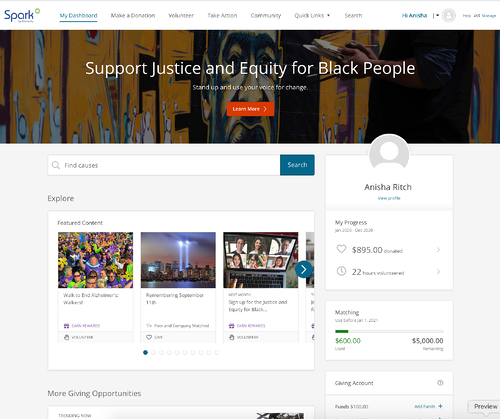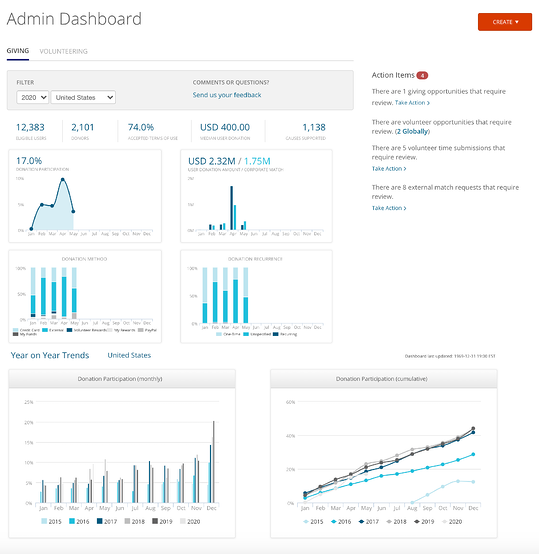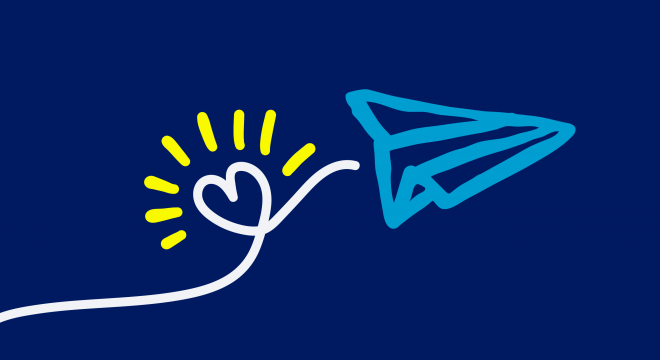November 30, 2017
How a Fortune 500 financial services company cut administration and boosted employee engagement with an integrated workplace giving software solution
Benevity recently spoke with a long-time client about how switching to an integrated workplace giving, volunteering and community investment software solution benefits the company’s employees, charities and program management team.
This Fortune 500 financial services company provides workplace giving and volunteering programs to more than 25,000 employees in the US, and runs a grants program that funds community groups. Initially, the programs were run through three separate platforms. Unfortunately, these platforms were troubled by a number of issues that affected program managers, users and the nonprofits they supported.
The Program Director recalls the problems that his team of eight full-timers dealt with on a regular basis. “There wasn’t just one major issue,” he says, “it was more of a death by a thousand cuts.” The technology-driven glitches included:
- Mistakes in payroll deductions
- Matches that were not processed properly
- Mistakes in the amounts nonprofits received
- Verification errors that resulted in slow processing of match requests
Bogged down in support and reporting
These concerns had a significant impact on the programs. The team was spending too much time supporting users and answering questions about the platforms. The high volume of requests often resulted in responses that were not timely or accurate, which created even more need for support.
“There wasn’t just one major issue, it was more of a death by a thousand cuts.”
The team was also spending substantial time tracking donations, match requests and distribution of funds. Reporting was manual, not automated, so it consumed a lot of administrative resources. And reports were not configurable, so the team couldn’t get some of the metrics they needed to assess program performance. As a result of these challenges, the team had less time to strategize on program growth.
Frustration mounting: the need to make a change
“The frustration level kept mounting until we knew we needed to make a change,” the Program Director recalls. The team’s number one goal was to reduce the need for support so they could focus on strategy, planning and execution. “We were looking for a solution that could manage all of our programs,” he says, “and offer an integrated experience so our users could seamlessly support their favorite causes with their time and money.”
They were also seeking a solution that could provide integrated reporting. Having three different systems meant running separate reports. “If we wanted to get a broad view of the support we were giving to an organization, we’d need to mash these three together,” the lead says. The ability to consolidate reporting was, therefore, a key consideration.
 Integrating platform, passion and innovation
Integrating platform, passion and innovation
After identifying a number of solutions that met their requirements, the company selected Spark, Benevity’s market-leading Goodness software. One deciding factor was Benevity’s culture. “Everyone we met with at Benevity—including the CEO and CTO—was clearly passionate about helping the nonprofit sector become more efficient and transparent in relation to fundraising costs,” he recalls. “The authenticity and audacity of Benevity were really appealing to me.”
Benevity’s innovative business model was another point of differentiation, particularly the charity support fee. Having worked in a variety of sectors, including nonprofit and financial services, the Program Director was aware that all financial transactions entail costs, including charitable donations. “It has always bothered me that some organizations obfuscate the true cost of running charities,” he says. “It just results in a starvation cycle that doesn’t help anyone.”
“Everyone we met with at Benevity—including the CEO and CTO—was clearly passionate about helping the nonprofit sector become more efficient and transparent in relation to fundraising costs.”
The Program Director understood that funds that would normally go to cover the financial transactional costs could be put to better use as matching funds that benefit charities. “By not paying the processing fees ourselves, we would be able to increase our total giving budget,” he says. This model, therefore, increases the net benefit to charities and, importantly, allows all parties to know up front how much the charities will receive.
Support requests down, engagement up!
Spark’s intuitive, easy and self-serve interface reduced much of the administrative burden of the previous solutions. “We used to have a system that looked like it was designed in the 1990s,” he says. “Now we get comments about how easy it is to use.” And the integration of the giving and volunteer programs has helped boost both.
Noting a spike in volunteer registrations during their giving campaigns, the team realized that when users logged in to make a donation, they were also signing up for volunteer events. Within two years of program launch, volunteer hours grew by 60% and individual dollars donated by 29%.
“We noticed a spike in volunteer registrations during our giving campaigns. When someone logs in to make a donation, they’re also going over to the volunteer section to sign up.”
After launching Spark, the team noticed a significant drop in employee support requests, significantly reducing their administrative burden. “It’s a night and day difference,” says the Program Director, “there’s no way of quantifying how much less time we’re spending on support, but it is dramatically less.”
More insights and time for planning
 Benevity's solution allows the data-driven company to run a number of custom, scheduled reports with no extra administrative resources or costs. The team can also configure the solution to create any additional reports they may need to tweak program performance. “We have a monthly scoreboard that tracks our key performance indicators,” the Program Director says. The reports that power this scoreboard are saved in the Benevity Reporting tool and instead of rebuilding them every month, the team can click a button and get updated data. “This allows us to track against our strategic goals and make corrections if needed.”
Benevity's solution allows the data-driven company to run a number of custom, scheduled reports with no extra administrative resources or costs. The team can also configure the solution to create any additional reports they may need to tweak program performance. “We have a monthly scoreboard that tracks our key performance indicators,” the Program Director says. The reports that power this scoreboard are saved in the Benevity Reporting tool and instead of rebuilding them every month, the team can click a button and get updated data. “This allows us to track against our strategic goals and make corrections if needed.”
Within Spark, employees can check the status of their own donations and match requests, and manage other activity from their personal dashboard, so the team doesn’t have to. Time that was previously spent on administrative tasks is now spent on strategy and planning. “With this additional time, we’re able to do other work to better engage our employees and advisors,” the lead explains. “We probably spend more time with reports now, but it’s because we can get the information more easily and use it.”
“With this additional time, we’re able to do other work to better engage our employees and advisors.”
Technology that is easy, simple and rewarding
The technology that supports giving and community investment programs should help, not hinder, CSR leaders. As the Program Director says, “Community relations technology should be easy, simple and rewarding, so people can focus on the good they are helping create in their community.” By leveraging a single software solution that manages it all, the team has empowered the company’s employees to do just that.
Schedule a demo to learn more about how you can boost employee engagement and build a culture of Goodness through an integrated solution.

